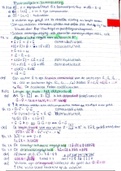Chapter 1 Chemical transport: drift and diffusion
diffusion; spontaneous spreading of molecules/particles over space
drift; movement induced by forces
friction/drag is a force that slows us down
moving particles slow down, due to friction, unless we apply force
𝑓
for small particles that move not to fast: 𝑣𝑑 = 𝜁 = applied force / drag coefficient = drift velocity
Stokes’ law: 𝜁 = 6𝜋𝜂𝑟
𝜂 = viscosity of the fluid medium (for water ≈1 × 10−3 𝑁/𝑚2 𝑠)
flux is a measure for the transported amount (𝐽 = 𝑐 ⋅ 𝑣𝑑 ) [𝐽] = 𝑚𝑜𝑙/𝑚2 /𝑠
sedimentation; heavier particles (dispersed in liquid) settle to the bottom of the vessel, under influence of
gravity
net force on a particle settling in fluid medium: 𝑓 = 𝑚𝑔 − 𝜌𝑓 𝑉𝑔 = 𝛥𝜌𝑉𝑔
● 𝜌𝑓 = density of surrounding fluid, 𝑉 = volume of particle
particles heavier than surrounding medium move downward, particles lighter than surrounding medium
move upward
diffusion; molecules spread out spontaneously
მ𝑐
𝐽 = −𝐷 with the last part being the slope of the concentration profile
მ𝑥
𝐷 = diffusion coefficient; how fast particles are diffusing (small molecules, water, roomtemp. 𝐷 ≈ 10−9 𝑚2 /𝑠)
მ𝑐
𝐽𝑡𝑜𝑡 = 𝐽𝑑𝑟𝑖𝑓𝑡 + 𝐽𝑑𝑖𝑓𝑓 = 𝑣𝑑 𝑐 − 𝐷
მ𝑥
equilibrium state; when there’s no net flux
𝑘𝐵 𝑇 𝑘𝐵 𝑇
𝑐(𝑥) = 𝑐(0)𝑒 −𝑚𝑔𝑥/𝜁𝐷 = 𝑐(0)𝑒 −𝑚𝑔𝑥/𝑘𝐵 𝑇 → 𝐷 = 𝜁
= 𝑧𝑒
𝑢
random walk of a particle:
in random walk, the length (𝜆) of each step is always the same (keep the direction in mind)
< 𝑥 2 >= 𝑖𝜆2 =< 𝑣 > 𝜆𝑡 = 2𝐷𝑡
2
3d displacement; < 𝑥 >= 6𝐷𝑡
𝐸𝑐𝑒𝑙𝑙
𝜀= 𝑙
(𝑙 = distance between electrodes) = electric field
, 𝑓𝐸 = 𝑧𝑒𝜀
positive ions: 𝑧 > 0, move towards negative electrode
negative ions: 𝑧 < 0, move towards positive electrode
𝑧𝑒
the mobility of the ion = 𝑢 = 𝜁
→ 𝑣𝑑 = 𝑢𝜀
hydrodynamic radius = the effective radius of the ion in water
electrophoresis: the migration of macroions in an electric field
high pH; most proteins have negative charge (all acidic and alkaline groups are deprotonated)
low pH; most proteins have positive charge (groups become protonated)
iso-electric point = pH where net charge is 0
𝑘𝐵 𝑇 𝑐𝑜𝑢𝑡
𝐸𝑚𝑒𝑚,𝑒𝑞 = 𝐸𝑜𝑢𝑡 − 𝐸𝑖𝑛 = − 𝑙𝑛
𝑧𝑒 𝑐𝑖𝑛
𝑐𝑜𝑢𝑡 < 𝑐𝑖𝑛 then 𝐸𝑜𝑢𝑡 > 𝐸𝑖𝑛
positive ions can receive electrons and negative ions can hand electrons over
𝐴𝐹 ∑ 𝑐𝑖 |𝑧𝑖 |𝑢𝑖
𝐼𝑖 = 𝐴𝐽𝑖 |𝑧𝑖 |𝐹 and 𝐼 = ( )𝐸𝑐𝑒𝑙𝑙
𝑙
with u=mobility of ions
𝐴𝐹 ∑ 𝑐𝑖 |𝑧𝑖 |𝑢𝑖
because 𝐼 = 𝑈/𝑅 and 𝐶 = 1/𝑅 → 𝐶 = 𝑙
and 𝐼 = 𝐶𝐸𝑐𝑒𝑙𝑙
conductivity: 𝜅 = ∑𝑖 𝜆𝑖 𝑐𝑖 = 𝐹 ∑𝑖 |𝑧𝑖 |𝑢𝑖 𝑐𝑖 and [𝜅] =/𝛺/𝑚
|𝑢
𝜆𝑖 = 𝐹|𝑧𝑖 𝑖 is the molar conductivity of ion i
, when ions begin to interact (higher concentration) this is not true and the conductivity becomes lower
diffusion; spontaneous spreading of molecules/particles over space
drift; movement induced by forces
friction/drag is a force that slows us down
moving particles slow down, due to friction, unless we apply force
𝑓
for small particles that move not to fast: 𝑣𝑑 = 𝜁 = applied force / drag coefficient = drift velocity
Stokes’ law: 𝜁 = 6𝜋𝜂𝑟
𝜂 = viscosity of the fluid medium (for water ≈1 × 10−3 𝑁/𝑚2 𝑠)
flux is a measure for the transported amount (𝐽 = 𝑐 ⋅ 𝑣𝑑 ) [𝐽] = 𝑚𝑜𝑙/𝑚2 /𝑠
sedimentation; heavier particles (dispersed in liquid) settle to the bottom of the vessel, under influence of
gravity
net force on a particle settling in fluid medium: 𝑓 = 𝑚𝑔 − 𝜌𝑓 𝑉𝑔 = 𝛥𝜌𝑉𝑔
● 𝜌𝑓 = density of surrounding fluid, 𝑉 = volume of particle
particles heavier than surrounding medium move downward, particles lighter than surrounding medium
move upward
diffusion; molecules spread out spontaneously
მ𝑐
𝐽 = −𝐷 with the last part being the slope of the concentration profile
მ𝑥
𝐷 = diffusion coefficient; how fast particles are diffusing (small molecules, water, roomtemp. 𝐷 ≈ 10−9 𝑚2 /𝑠)
მ𝑐
𝐽𝑡𝑜𝑡 = 𝐽𝑑𝑟𝑖𝑓𝑡 + 𝐽𝑑𝑖𝑓𝑓 = 𝑣𝑑 𝑐 − 𝐷
მ𝑥
equilibrium state; when there’s no net flux
𝑘𝐵 𝑇 𝑘𝐵 𝑇
𝑐(𝑥) = 𝑐(0)𝑒 −𝑚𝑔𝑥/𝜁𝐷 = 𝑐(0)𝑒 −𝑚𝑔𝑥/𝑘𝐵 𝑇 → 𝐷 = 𝜁
= 𝑧𝑒
𝑢
random walk of a particle:
in random walk, the length (𝜆) of each step is always the same (keep the direction in mind)
< 𝑥 2 >= 𝑖𝜆2 =< 𝑣 > 𝜆𝑡 = 2𝐷𝑡
2
3d displacement; < 𝑥 >= 6𝐷𝑡
𝐸𝑐𝑒𝑙𝑙
𝜀= 𝑙
(𝑙 = distance between electrodes) = electric field
, 𝑓𝐸 = 𝑧𝑒𝜀
positive ions: 𝑧 > 0, move towards negative electrode
negative ions: 𝑧 < 0, move towards positive electrode
𝑧𝑒
the mobility of the ion = 𝑢 = 𝜁
→ 𝑣𝑑 = 𝑢𝜀
hydrodynamic radius = the effective radius of the ion in water
electrophoresis: the migration of macroions in an electric field
high pH; most proteins have negative charge (all acidic and alkaline groups are deprotonated)
low pH; most proteins have positive charge (groups become protonated)
iso-electric point = pH where net charge is 0
𝑘𝐵 𝑇 𝑐𝑜𝑢𝑡
𝐸𝑚𝑒𝑚,𝑒𝑞 = 𝐸𝑜𝑢𝑡 − 𝐸𝑖𝑛 = − 𝑙𝑛
𝑧𝑒 𝑐𝑖𝑛
𝑐𝑜𝑢𝑡 < 𝑐𝑖𝑛 then 𝐸𝑜𝑢𝑡 > 𝐸𝑖𝑛
positive ions can receive electrons and negative ions can hand electrons over
𝐴𝐹 ∑ 𝑐𝑖 |𝑧𝑖 |𝑢𝑖
𝐼𝑖 = 𝐴𝐽𝑖 |𝑧𝑖 |𝐹 and 𝐼 = ( )𝐸𝑐𝑒𝑙𝑙
𝑙
with u=mobility of ions
𝐴𝐹 ∑ 𝑐𝑖 |𝑧𝑖 |𝑢𝑖
because 𝐼 = 𝑈/𝑅 and 𝐶 = 1/𝑅 → 𝐶 = 𝑙
and 𝐼 = 𝐶𝐸𝑐𝑒𝑙𝑙
conductivity: 𝜅 = ∑𝑖 𝜆𝑖 𝑐𝑖 = 𝐹 ∑𝑖 |𝑧𝑖 |𝑢𝑖 𝑐𝑖 and [𝜅] =/𝛺/𝑚
|𝑢
𝜆𝑖 = 𝐹|𝑧𝑖 𝑖 is the molar conductivity of ion i
, when ions begin to interact (higher concentration) this is not true and the conductivity becomes lower










